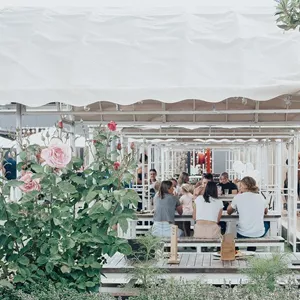Sustainable Period Care: Sexologist Chantelle Otten Answers All Our Questions
Sexologist Chantelle Otten on all things sustainable period care.
When it comes to period products, there are a range of options on the market – and we’re blessed to have them so readily available to us when there are plenty of women around the world who don’t have access to period care. Whether you opt for pads, tampons, period underwear or something else, we all have our own individual preferences. After all, when it comes to that time of the month, we want to ensure we’re as comfortable and gentle on our bodies as possible.
But what if we told you that it takes between 500 to 800 years for traditional sanitary products like pads and tampons to break down? Although they’re easy to obtain – you simply knock it into your trolley during your weekly grocery shop – they can cause far more harm than good to the planet.
Luckily, sustainable period care options have become more widely produced – and used – in recent years. And while some are already onto the sustainable period products, others are yet to dip their toes in. So, we spoke to sexologist and Hello Period ambassador, Chantelle Otten, to learn more about sustainable sanitary products and why we should make the switch.
Why Should People Opt for Sustainable Period Care Over Single Use Products?
“Choosing sustainable period care options over traditional single-use products isn't just about the environment – it's also about taking care of yourself,” Chantelle tells Sitchu.
Sanitary products such as pads and tampons contain plastic in them. In fact, there is 36 grams of plastic in a packet of period pads, which is equivalent to five plastic bags. Chantelle says that switching to sustainable options is better for your health since your limiting your exposure to those chemicals and plastics.
“They also save you money in the long run and reduce waste, which is great for our planet,” she continues.
What Sustainable Period Care Options Do I Have?
Period products have come a long way since the original menstrual cup was created in 1937 by actress Leona Chalmers. Now, there is a plethora of different options available to cater to various different needs, religious beliefs and personal preferences. While the most well-known reusable period products include menstrual cups and period underwear, there are other options available, including reusable pads, liners and menstrual discs.
“If you’re thinking about moving away from traditional period care to more sustainable options… Consider factors such as your comfort level, menstrual flow, and daily activities when selecting a sustainable option,” Chantelle informs Sitchu. “Each type of sustainable period care has its learning curve, but with practice, you'll become more comfortable.”
Menstrual Cups
Menstrual cups are one of the most well-known sustainable reusable period care products. They’re shaped like a cup and are inserted into the vagina to collect menstrual fluid, and they have a tab on the end that’s used to pull it out. Chantelle says since they collect menstrual flow rather than absorb it, menstrual cups help to maintain natural pH levels and reduce dryness that tampons can cause.
“Menstrual cups offer some fantastic health benefits and sustainability advantages compared to traditional period products,” Chantelle explains. “They're made from medical-grade silicone, which means they're gentler on your body and reduce the risk of irritation and toxic shock syndrome often associated with tampons.”
Plus, when it comes to sustainability, menstrual cups can be reused for years, meaning you’re not spending money on sanitary pads or tampons every single month. In the long run, it can save you a lot of money.
Where to buy menstrual cups:
Hello Period - Hello Cup, $49.99
Diva – Diva Cup, $35
Lunette – Lunette Cup, $48
Menstrual Discs
While menstrual cups and menstrual discs look somewhat similar, and are both sustainable period care products, they differ in their design and function.
“A menstrual cup is typically bell-shaped and made of flexible silicone or rubber. It’s inserted into the vagina [and] form[s] a seal against the vaginal walls,” Chantelle says. “On the other hand, a menstrual disc is shaped like a disc or a small frisbee with a rim, designed to sit at the base of the cervix to collect menstrual flow.”
“I prefer the menstrual disc because of its unique design that allows it to collect more blood and provide mess-free period sex.”
Where to buy menstrual discs:
Hey Zomi – Reusable Menstrual Disc, $55
Hello Period – Menstrual Disc, $59.99
Nixit – Nixit Menstrual Cup, $70
Reusable Pads
Reusable period pads consist of absorbent fabric layers like cotton or bamboo, and they often have a waterproof layer to prevent leaks. Commonly, they have silicone (or similar) on the underside of the pad to prevent from sliding around, or they’ll have wings that can be snap-buttoned into place at the bottom of the underwear. They can be worn for longer than regular pads since they’re more absorbent, and can be washed and re-worn.
Where to buy reusable pads:
TOM Organic – Reusable Pad, $17
Rudie – Rudie Signature Pads + Free Wet Bag (3 Pads), $39.99
Hello Period – Hello Pad, $18.99
Period Underwear
Period undies are another popular sustainable period care option that a lot of people go for due to their comfort and ease of use. Similar to reusable pads, period underwear is often made from cotton or bamboo and has numerous layers and technology that absorbs fluid, wicks away moisture and keeps you dry.
Where to buy period underwear:
Scarlet Period – Period Underwear, from $22
Modibodi – Period Underwear, from $18
What Are Some Misconceptions About Sustainable Period Care?
There are several misconceptions floating around about sustainable period products due to a lack of knowledge surrounding them. Two of the most common ones are that they’re difficult to use and uncomfortable, along with being messy.
“With a bit of practice, most find them as easy and comfortable as traditional products,” Chantelle points out. “In reality, once you learn how to use them properly, they can be mess-free and even more hygienic.”
“There's also a misconception that reusable products are less hygienic than disposables. In fact, as long as they are properly cleaned and stored between uses, they are just as hygienic, if not more so, than single-use options.”
Chantelle also tells us that some people believe menstrual cups or discs are only suited to certain body types, which is not the case. There are multiple sizes and shapes available for each person’s needs from various brands, so there’s something out there for everyone.
What is Some Advice You Can Offer Anyone Thinking of Turning to More Sustainable Period Care Products?
No matter the period product you choose to go for (or if you want to try multiple), Chantelle says it’s crucial to learn how to use the product correctly. Take time to properly understand how to insert it, how long it can be worn, and how to remove and clean it.
“Be patient with yourself during the adjustment period,” Chantelle says. “It may take a few menstrual cycles to fully adapt to a new product, so give yourself time and don't be discouraged by initial challenges.”
Have you enjoyed our piece on sustainable period care with Chantelle Otten and are now eager to explore more ways to incorporate sustainability into your daily routine? Dive into our sustainable hair care guide and discover this stylish cleaning brand committed to eliminating plastic waste.










